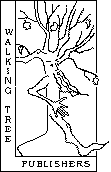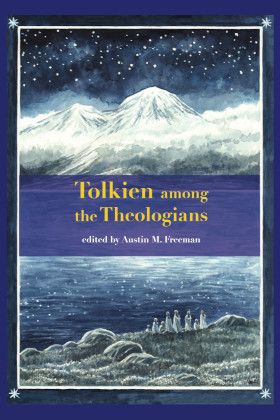Tolkien among the Theologians
Austin M. Freeman (editor)
Cormarë Series No. 53

<--previous | all publications | next-->
how to buy this item
Can Tolkien be considered a theologian? In this collection of essays, scholars bring Tolkien into conversation with theologians from the patristic era to the 20th Century: Augustine, Boethius, Francis of Assisi, Thomas Aquinas, John Calvin, John Henry Newman, G.K. Chesterton, Hans Urs von Balthasar, John Paul II, and the Birmingham Oratorians. Far from siloing o his expertise into a single fi eld, Tolkien was an interdisciplinary thinker with a synthetic mind that drew from the full breadth of the Great Tradition to construct a compelling account of God and all things in relation to God.
table of contents | abstracts | cover | announcements | more

Series Editors’ Preface
Introduction by Austin M. Freeman
Craig A. Boyd
Saruman’s Folly and Gandalf’s Wisdom:
Augustinian Rhetoric in The Lord of the Rings
(abstract)
Matthew J.J. Hoskin
Power and Weakness in Middle-earth:
Boethius and Tolkien’s The Lord of the Rings
(abstract)
Keith A. Mathison
Franciscan Spirituality in the House of Tom Bombadil
(abstract)
Claudio A. Testi
Aquinas, Tolkien, and the Music of Niggle
(abstract)
Austin M. Freeman
Tolkien and Calvin:
Five Convergences
(abstract)
Giuseppe Pezzini
Tolkien and Newman:
Towards a Theology of History
(abstract)
Zachary D. Schmoll
Tolkien and Chesterton:
The Orthodoxy of Middle-earth
(abstract)
Lisa Coutras
Tolkien and Balthasar:
Theological Aesthetics in Tolkien's Writings
(abstract)
Łukasz Neubauer
Tolkien and John Paul II:
The Civilisation of Death and Its Resonances in Arda
(abstract)
Holly Ordway
Tolkien in His Contemporary Context:
Among the Oratorians and the Jesuits
(abstract)
Timothy Padgett
Tolkien and Twentieth Century Ecumenism
(abstract)
table of contents | abstracts | cover | announcements | more

Abstracts
Introduction by Austin M. Freeman
Saruman’s Folly and Gandalf’s Wisdom:
Augustinian Rhetoric in The Lord of the Rings
This chapter contrasts Saruman and Gandalf according to Augustine of Hippo’s writings on rhetoric, and specifically the goal of good rhetoric as opposed to sophistry. Augustine asserts that the rhetor ought to prize the good of his audience, which means their orientation toward God, rather than merely using words as a tool of domination. The paper analyzes the two pivotal scenes between the wizards at Orthanc to demonstrate his case
Power and Weakness in Middle-earth:
Boethius and Tolkien’s The Lord of the Rings
Boethius’s Consolation of Philosophy is one of the great yet final works of ancient philosophy but also an enduring work of medieval philosophy, one with which Tolkien was very familiar and to which he had access in Latin, Old English, Middle English, and modern English. This chapter explores how Boethian themes of power and goodness penetrate The Lord of the Rings. After discussing Boethius’s teaching that true power can only reside in goodness and is ultimately unshakeable and, in a sense, interior, the chapter examines the figures of Théoden and Denethor and how their own relationship to power demonstrates this fact, showing how Denethor’s true weakness lay in despair and Theoden’s lay in hope.
Franciscan Spirituality in the House of Tom Bombadil
Tom Bombadil has long been one of the most enigmatic characters in The Lord of the Rings. This chapter argues that Tom came into Middle-earth from a different sub-created world with a different system and a different history. He is a character from a different tale who was drawn in to Middle-earth in order to provide an adventure for the hobbits. This chapter also argues that Tolkien uses the mysterious character of Tom Bombadil to absorb Roman Catholic religious elements into the story of The Lord of the Rings. Tom specifically represents a particular aspect of Roman Catholic spirituality exemplified by Francis of Assisi: renunciation of power and possessions, pacifism, love for and communion with nature, devotion to Mary, and an almost childlike penchant for joyful song.
Aquinas, Tolkien, and the Music of Niggle
In this article I would like to explain the relationship between Tolkien and Aquinas (and theology in general), and then examine in detail a Tolkienian theological question that I believe has received little study. In particular, I will try to
demonstrate that:
- Tolkien’s writings do not express a completely Thomistic perspective.
- Tolkien, instead, was fundamentally a narrator because, for
him, theology lies in the function of the stories, therefore he
wrote theological passages above all to give coherence to his stories.
- Nevertheless, in Tolkien’s work, there is profound theological content, as
I will show by analysing "Leaf by Niggle", his letters, and his
legendarium.
Tolkien and Calvin: Five Convergences
This chapter investigates five significant ways in which Tolkien’s theology coheres with that of John Calvin. First, they both emphasize the importance of original language research and humanist study of the liberal arts. Second, they highlight the metaphysical impact of promises and covenants. Third, they target idolatry as a key theological enemy. Fourth, they exalt the created order as an avenue toward divine worship. Fifth, and most surprisingly to most, Tolkien fulfills all six of Calvin’s criteria for a doctrine of God’s providence.
Tolkien and Newman: Towards a Theology of History
This chapter explores aspects of John Henry Newman’s influence on J.R.R. Tolkien, focusing in particular on their shared perspectives on change and development, as well as the humble secrecy of divine action in history. Despite his significant biographical connections to the English Cardinal, Tolkien rarely refers to Newman directly in his texts, and the affinity between the two writers is often overlooked. However, Tolkien’s view of change as “the law of the world under the sun” closely mirrors Newman’s conviction that in human history, “to live is to change, and to be perfect is to have changed often.” Both thus saw change, though often painful, as an essential part of life in this world. While they might sympathise with the reluctance of some to embrace change, as seen in the case of the Elves (the ‘embalmers’), they expressed an attitude that was neither conservative nor progressive, but one that views change as renewal and development in continuity with the past. The chapter also examines the theme of secrecy in divine action, which is also central in Tolkien’s literary works, where humble characters, like Hobbits, unexpectedly drive the course of history according to “the secret life in creation.” This recalls Newman’s insistence on the idea that God’s providence manifests itself in a hidden and quiet way, often overlooked by the world, and reveals a shared belief in the power of the powerless, which can also be related to their affection for figures like Mary and St. Philip Neri.
Tolkien and Chesterton: The Orthodoxy of Middle-earth
In many ways, Tolkien and Chesterton were kindred spirits, sharing many similar perspectives on adventure, patriotism, and stories. Tolkien is known to have been familiar with the work of Chesterton, so while this chapter does not seek to prove a necessary causal connection between the two, it seeks to explore the ways in which elements of specifically Chesterton’s Orthodoxy, one of Chesterton’s works his works we know that Tolkien read, might have been an inspiration for the quest in Middle-earth.
Tolkien and Balthasar: Theological Aesthetics in Tolkien's Writings
Tolkien and Hans Urs von Balthasar are both thinkers who emphasize the role of beauty as a transcendental alongside goodness and truth. This paper discusses how the affective element plays a role in faith and explores how Tolkien’s two most prominent female characters, Galadriel and Éowyn, display their particular beauties. Galadriel is an echo of Mary’s character, of the beauty of her soul. Likewise Éowyn, also physically beautiful, allows her physical form to be a translucent vehicle for inner beauty.
Tolkien and John Paul II: The Civilisation of Death and Its Resonances in Arda
This paper investigates how Pope John Paul II’s idea of the ‘civilization of death’, which is characterized by abortion and euthanasia, sets itself against the ‘civilization of life’ that prioritizes human flourishing before God. While Tolkien and John Paul likely never had direct intellectual contact, Tolkien’s condemnation of Denethor’s suicide and the newly-published details of Elvish childbirth in The Nature of Middle-earth are in alignment with John Paul’s traditional Roman Catholic condemnation of abortion and euthanasia.
Tolkien in His Contemporary Context: Among the Oratorians and the Jesuits
As an English Catholic Christian of the 20th century, with his roots in Birmingham and most of his adult life in Oxford, Tolkien had more interaction with contemporary theologians than can readily be estimated from references in his writing. This essay focuses specifically on Tolkien’s interactions with the Oratorians and the Jesuits. In his childhood and youth, he was formed by the spirituality of the Congregation of the Oratory of St. Philip Neri at the Birmingham Oratory, for which Robert Eaton, one of the Oratorian priests in Birmingham in Tolkien’s youth, stands as an example. At Oxford as a student and later a professor, he interacted with a number of Jesuit theologians; this essay considers Joseph Rickaby, C.C. Martindale, and Martin D’Arcy. A detailed consideration of biographical context helps scholars to consider the chronology of possible influences on the theological and spiritual elements of the legendarium, to establish the relative importance of certain influences and ideas, and to exercise appropriate caution in making arguments from silence. Appreciating Tolkien’s place among his contemporary theologians helps us better to understand his world, and therefore better to understand, and fruitfully explore, his work.
Tolkien and Twentieth Century Ecumenism
Tolkien’s works have been a treasure for the world since they first appeared decades ago. One of their most amazing qualities is how people from all walks of life and perspectives, people who might well not get along when face to face, all of these may join in a shared joy for these wonderful works. This ability to pull together people of vast differences is not limited to fantasy fans but was demonstrated in Tolkien’s life and letters. With the literary friends of Legolas and Gimli and Tolkien’s real life friendship, Christians have a veritable how-to for building ecumenical bonds that yet maintain individual integrity.
table of contents | abstracts | cover | announcements | more

Cover
Cover illustration,
table of contents | abstracts | cover | announcements | more

Announcements
Tolkien among the Theologians published (23rd April 2025)

208 pages, Walking Tree Publishers 2025, Cormarë Series No. 53, Editor: Austin M. Freeman
, ISBN: 978-3-905703-53-5.

<--previous | all publications | next-->
how to buy this item

More on Tolkien among the Theologians

terms and conditions
visitors since
last updated


